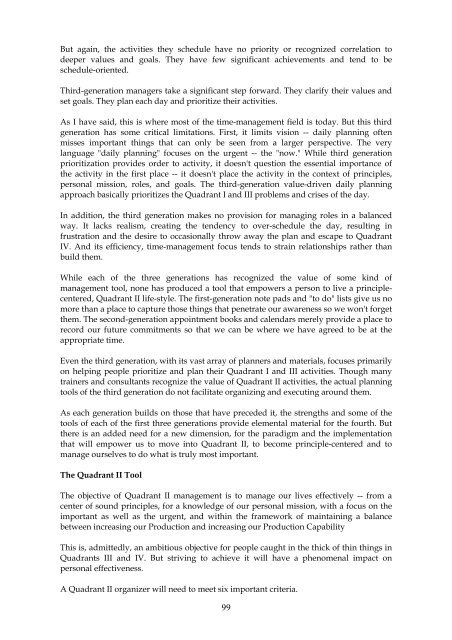Covey - The 7 habits of highly effective people
Create successful ePaper yourself
Turn your PDF publications into a flip-book with our unique Google optimized e-Paper software.
But again, the activities they schedule have no priority or recognized correlation to<br />
deeper values and goals. <strong>The</strong>y have few significant achievements and tend to be<br />
schedule-oriented.<br />
Third-generation managers take a significant step forward. <strong>The</strong>y clarify their values and<br />
set goals. <strong>The</strong>y plan each day and prioritize their activities.<br />
As I have said, this is where most <strong>of</strong> the time-management field is today. But this third<br />
generation has some critical limitations. First, it limits vision -- daily planning <strong>of</strong>ten<br />
misses important things that can only be seen from a larger perspective. <strong>The</strong> very<br />
language "daily planning" focuses on the urgent -- the "now." While third generation<br />
prioritization provides order to activity, it doesn't question the essential importance <strong>of</strong><br />
the activity in the first place -- it doesn't place the activity in the context <strong>of</strong> principles,<br />
personal mission, roles, and goals. <strong>The</strong> third-generation value-driven daily planning<br />
approach basically prioritizes the Quadrant I and III problems and crises <strong>of</strong> the day.<br />
In addition, the third generation makes no provision for managing roles in a balanced<br />
way. It lacks realism, creating the tendency to over-schedule the day, resulting in<br />
frustration and the desire to occasionally throw away the plan and escape to Quadrant<br />
IV. And its efficiency, time-management focus tends to strain relationships rather than<br />
build them.<br />
While each <strong>of</strong> the three generations has recognized the value <strong>of</strong> some kind <strong>of</strong><br />
management tool, none has produced a tool that empowers a person to live a principlecentered,<br />
Quadrant II life-style. <strong>The</strong> first-generation note pads and "to do" lists give us no<br />
more than a place to capture those things that penetrate our awareness so we won't forget<br />
them. <strong>The</strong> second-generation appointment books and calendars merely provide a place to<br />
record our future commitments so that we can be where we have agreed to be at the<br />
appropriate time.<br />
Even the third generation, with its vast array <strong>of</strong> planners and materials, focuses primarily<br />
on helping <strong>people</strong> prioritize and plan their Quadrant I and III activities. Though many<br />
trainers and consultants recognize the value <strong>of</strong> Quadrant II activities, the actual planning<br />
tools <strong>of</strong> the third generation do not facilitate organizing and executing around them.<br />
As each generation builds on those that have preceded it, the strengths and some <strong>of</strong> the<br />
tools <strong>of</strong> each <strong>of</strong> the first three generations provide elemental material for the fourth. But<br />
there is an added need for a new dimension, for the paradigm and the implementation<br />
that will empower us to move into Quadrant II, to become principle-centered and to<br />
manage ourselves to do what is truly most important.<br />
<strong>The</strong> Quadrant II Tool<br />
<strong>The</strong> objective <strong>of</strong> Quadrant II management is to manage our lives <strong>effective</strong>ly -- from a<br />
center <strong>of</strong> sound principles, for a knowledge <strong>of</strong> our personal mission, with a focus on the<br />
important as well as the urgent, and within the framework <strong>of</strong> maintaining a balance<br />
between increasing our Production and increasing our Production Capability<br />
This is, admittedly, an ambitious objective for <strong>people</strong> caught in the thick <strong>of</strong> thin things in<br />
Quadrants III and IV. But striving to achieve it will have a phenomenal impact on<br />
personal <strong>effective</strong>ness.<br />
A Quadrant II organizer will need to meet six important criteria.<br />
99


